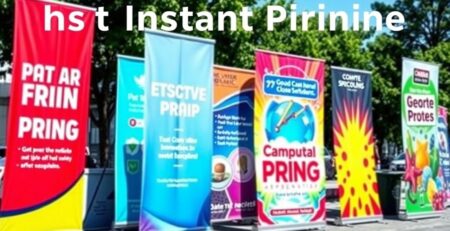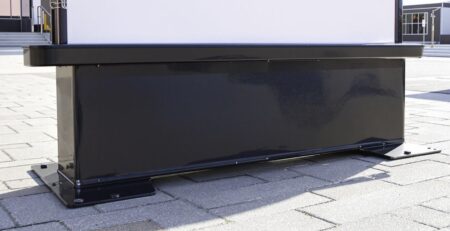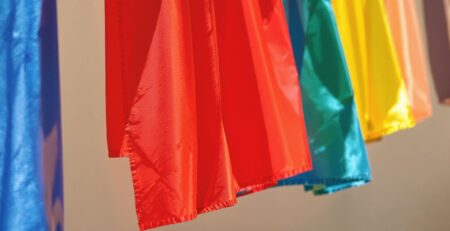Transform Your Space with Eye-Catching Vinyl Signs: A Comprehensive Guide
Vinyl signs are a fantastic way to add flair to any environment, whether it’s for your home or business. They come in various styles and can be customized to fit your specific needs. From promoting your brand to sprucing up a dull wall, vinyl signs offer a blend of creativity and practicality. This guide will walk you through everything you need to know about vinyl signs, from design to installation and maintenance, so you can make the most of this versatile signage option.
Key Takeaways
- Vinyl signs are customizable and can be tailored to fit any design need.
- They are durable and can withstand various environmental factors, making them suitable for both indoor and outdoor use.
- Installation of vinyl signs is relatively simple and can often be done without professional help.
- Regular cleaning and care can extend the life of your vinyl signs, keeping them looking fresh and vibrant.
- Staying updated with design trends can help you create eye-catching and modern vinyl signage.
Understanding Vinyl Signs
What Are Vinyl Signs?
Vinyl signs are basically graphics or lettering cut from thin, flexible vinyl material with an adhesive backing. They stick to all sorts of surfaces, from windows and walls to vehicles and floors. Think of them as super-versatile stickers that can be used for anything from simple lettering to complex, full-color designs. They’re a popular choice for businesses and individuals because they’re relatively cheap, easy to apply, and can last a good while. You can get vinyl graphics materials in a ton of colors and finishes, so you can really customize them to fit your needs.
Benefits of Using Vinyl Signs
Vinyl signs have a lot going for them. Here’s a quick rundown:
- Cost-Effective: Compared to other types of signage, vinyl is pretty budget-friendly.
- Versatile: You can use them indoors or outdoors, on just about any smooth surface.
- Customizable: Colors, fonts, sizes – you name it, you can customize it. Want printed vinyl? No problem.
- Durable: They can withstand weather and wear and tear, especially if you go for a higher-quality vinyl.
- Easy to Apply: Most vinyl signs are designed for easy DIY installation.
Vinyl signs are a great way to get your message out there without breaking the bank. They’re durable, versatile, and can be customized to fit any need. Plus, they’re easy to install, so you can get your sign up and running in no time.
Common Applications of Vinyl Signs
Vinyl signs are everywhere! Here are some common places you’ll see them:
- Storefronts: Business names, hours, logos on windows and doors.
- Vehicles: Company logos, contact info, or decorative wraps on cars and trucks.
- Walls: Interior decor, motivational quotes, or informational signs in offices and homes.
- Banners: Temporary signage for events, promotions, or announcements.
- Wayfinding: Directional signs in buildings, parking lots, and public spaces. They are ideal for simple wayfinding.
Designing Your Vinyl Signs
Choosing the Right Colors
Color selection is super important when you’re designing vinyl banners. It’s not just about picking your favorite shades; it’s about what message you want to send and how well those colors will show up in the environment where the sign will be. Think about contrast – you want your text to pop! Also, consider the psychology of colors. For example, blue often conveys trust and stability, while red can create a sense of urgency or excitement. Don’t forget to factor in your brand colors to maintain consistency.
- Consider the location of the sign and how the colors will appear in different lighting conditions.
- Use color palettes to ensure harmonious combinations.
- Test your color choices on a small scale before committing to a large print.
Incorporating Custom Graphics
Custom graphics can really make your vinyl sign stand out. Whether it’s your company logo, illustrations, or photographs, high-quality visuals are key. Make sure your images are high resolution to avoid pixelation. If you’re not a designer, consider hiring a professional to create graphics that align with your brand and message. Think about the overall composition – you don’t want the graphics to overwhelm the text or vice versa. Keep it balanced and visually appealing.
Selecting Fonts and Typography
Choosing the right font is more than just picking something that looks nice; it’s about readability and conveying the right tone. A fancy script might look elegant, but if people can’t read it from a distance, it’s not doing its job. Opt for fonts that are clear, legible, and appropriate for your brand. Consider the size of the font in relation to the size of the sign – you want it to be easily readable from a distance. Also, think about using different font weights (bold, regular, light) to create visual hierarchy and emphasize key information.
- Limit the number of fonts used to avoid a cluttered look.
- Ensure sufficient spacing between letters and lines for readability.
- Test the font on different backgrounds to ensure contrast and clarity.
When designing vinyl signs, remember that less is often more. A clean, simple design with a clear message is more effective than a cluttered, complicated one. Focus on conveying your message quickly and effectively, and don’t be afraid to leave some white space. The goal is to grab attention and communicate your message in a memorable way.
Installation Techniques for Vinyl Signs
Preparing the Surface
Okay, so before you even think about slapping that vinyl graphic onto anything, you’ve gotta prep the surface. I mean, seriously, this is the most important step. If you skip this, you’re basically setting yourself up for failure. Think of it like painting – you wouldn’t paint over a dirty wall, right? Same deal here.
- First, give the surface a good cleaning. Soap and water work wonders. Get rid of all the dust, dirt, and grime. Seriously, all of it.
- Next, make sure it’s dry. Bone dry. Any moisture will mess with the adhesive.
- Finally, if the surface is glossy, you might want to lightly sand it to give the vinyl something to grip onto. Just a little scuffing will do the trick.
I remember this one time, I was in a rush and didn’t clean a wall properly before applying a huge vinyl decal. It looked great for about a week, and then it started peeling off. What a waste of time and money! Learn from my mistakes, people.
Step-by-Step Installation Guide
Alright, now for the fun part – actually putting up the sign! Don’t worry, it’s not rocket science, but you do need to be patient and careful. Rushing is the enemy here.
- Positioning is key. Before you peel anything, hold the vinyl up to the surface and make sure it’s exactly where you want it. Use a level to ensure it’s straight. Masking tape can be your best friend here – use it to temporarily hold the vinyl in place.
- Peel off a small section of the backing paper. Start at one corner and slowly peel it back, exposing the adhesive. Don’t peel it all off at once!
- Apply the exposed adhesive to the surface. Use a squeegee (or even a credit card in a pinch) to smooth it down, working from the center outwards. This helps prevent air bubbles.
- Slowly peel off the rest of the backing paper, continuing to smooth the vinyl as you go. Take your time and be careful to avoid wrinkles or bubbles.
- Once the entire vinyl is applied, go over it again with the squeegee, applying firm pressure to ensure it’s fully adhered.
- Finally, carefully peel off any transfer tape (if your vinyl has it). Do this slowly and at a shallow angle to avoid lifting the vinyl.
Tips for a Professional Finish
Want your vinyl signs to look like they were installed by a pro? Here are a few extra tips:
- Temperature matters. Don’t install vinyl in extreme temperatures (too hot or too cold). The adhesive works best at room temperature.
- Use a heat gun (carefully!) to help conform the vinyl to curved surfaces. Just be careful not to overheat it, or you’ll melt the vinyl.
- If you do get air bubbles, you can try pricking them with a pin and then smoothing them out with the squeegee. For larger bubbles, you might need to carefully lift the vinyl and reapply it.
- Don’t be afraid to ask for help! If you’re installing a large or complex vinyl sign, it’s always easier with two people. One person can hold the vinyl in place while the other smooths it down.
| Tool | Use | photograph the vinyl sign. I need to see the sign in action. I need to see the sign in action. I need to see the sign in action.
Maintaining Your Vinyl Signs

Cleaning and Care Instructions
Keeping your vinyl signs looking fresh isn’t hard, but it does take a little effort. Regular cleaning is key to extending the life of your signs. For indoor signs, a simple dusting with a soft cloth will usually do the trick. For outdoor signs, you’ll want to wipe them down with a damp cloth. Avoid harsh chemicals or abrasive cleaners, as these can damage the vinyl. Mild soap and water are generally your best bet. Think of it like washing your car – gentle is better!
Protecting Against Fading
Sunlight can be a real enemy to vinyl signs, causing the colors to fade over time. While many vinyls are UV resistant, prolonged exposure can still take its toll. Here are a few things you can do to protect your signs:
- Consider the placement: If possible, position your signs in areas that receive less direct sunlight. This is especially important for outdoor signs.
- Use UV-protective coatings: There are special coatings you can apply to your vinyl signs to help block UV rays. These coatings can significantly extend the life of your colors.
- Window films: If your sign is behind a window, consider using a UV-blocking window film. This can help protect both the sign and anything else in the room from sun damage.
Repairing Minor Damage
Even with the best care, minor damage can sometimes occur. Small tears or bubbles can often be repaired with a little patience and the right tools. Here’s a quick guide:
- Small tears: For small tears, you can use a clear vinyl repair tape. Carefully apply the tape over the tear, making sure to smooth out any wrinkles or bubbles.
- Bubbles: If you have air bubbles under the vinyl, you can try to smooth them out with a squeegee or a credit card. If that doesn’t work, you can carefully prick the bubble with a pin and then smooth it out.
- Loose edges: If the edges of your vinyl sign are starting to peel up, you can use a vinyl adhesive to re-secure them. Make sure to clean the surface before applying the adhesive.
Taking care of your vinyl signs doesn’t have to be a chore. A little regular maintenance can go a long way in keeping them looking their best for years to come. Think of it as an investment in your brand and your space. Plus, a clean, well-maintained sign just looks more professional!
Trends in Vinyl Signage

Vinyl signs aren’t just practical; they’re also keeping up with the times! Here’s a peek at what’s hot in the world of vinyl signage right now.
Geometric Patterns
Geometric patterns are super popular for a modern, clean look. Think triangles, hexagons, and other shapes arranged in cool ways. They can add a sense of order and style to any space. You’ll see these used a lot in offices and retail stores to give off a contemporary vibe. They’re bold and eye-catching, for sure.
Nature-Inspired Designs
Bringing the outdoors in is a big trend, and nature-inspired vinyl signs are a great way to do it. We’re talking botanical prints, landscapes, and anything that reminds you of nature. These are perfect for creating a calming atmosphere in homes, spas, or even offices. Imagine a wall covered in a subtle forest scene – pretty relaxing, right?
Interactive and 3D Effects
Vinyl signs are getting more high-tech! With advancements in printing, you can now get vinyl signs with cool 3D effects. These add depth and dimension, making your signs really stand out. Also, some signs are becoming interactive, maybe with QR codes that link to more information or even augmented reality experiences. It’s all about making the sign more engaging. Consider using vinyl lettering to add a personal touch to your space.
Vinyl signs are constantly evolving. What was once a simple way to display information is now a canvas for creativity and innovation. From bold geometric designs to calming nature scenes and interactive elements, there’s a vinyl sign trend to suit every style and need.
Vinyl Signs for Businesses
Enhancing Brand Visibility
Vinyl signs are a fantastic way for businesses to get their name out there. They’re super customizable, so you can really make them match your brand’s look and feel. Think about it: a bright, eye-catching sign can draw in customers who might otherwise walk right past your store. It’s like a silent salesperson working 24/7. You can use adhesive vinyl decals on windows, walls, or even floors to create a cohesive brand experience. It’s all about making a lasting impression.
Using Vinyl Signs for Promotions
Need to announce a sale or a new product? Vinyl signs are your friend. They’re easy to update, so you can swap out old promotions for new ones without breaking the bank. Plus, they’re durable enough to withstand the elements, so you can use them indoors or outdoors. Here’s a few ideas:
- Window Clings: Perfect for short-term promotions.
- Banners: Great for announcing grand openings or special events.
- Floor Graphics: A fun way to guide customers to specific products.
Vinyl signs are a cost-effective way to promote your business and attract new customers. They’re versatile, durable, and easy to install, making them a great choice for any business owner.
Wayfinding and Informational Signs
Don’t underestimate the power of clear and concise wayfinding signs. Vinyl is perfect for creating these! Think about directing customers to different departments, marking restrooms, or providing important safety information. A well-placed advertising flags can make a huge difference in customer experience. No one wants to wander around aimlessly trying to find what they need. Here’s why vinyl works so well:
- Easy to Read: Vinyl signs can be printed in a variety of fonts and colors.
- Durable: They can withstand wear and tear from foot traffic.
- Customizable: You can create signs that match your brand’s aesthetic.
Here’s a simple table showing the benefits of using vinyl for wayfinding:
| Feature | Benefit |
|---|---|
| Customizability | Matches brand, clear messaging |
| Durability | Long-lasting, reduces replacement costs |
| Cost-Effectiveness | Affordable signage solution |
Choosing the Right Vinyl Material
Choosing the correct vinyl material is a big deal for any sign project. It impacts not only the look but also how long your sign will last and how well it holds up against the elements. There are a few things to consider before making a choice.
Types of Vinyl Materials
There are two main types of vinyl: calendered and cast. Calendered vinyl is made by mixing ingredients and squeezing them through rollers. It’s a quicker process, making it a more affordable option. It’s good for short-term uses like exhibition graphics. Cast vinyl, on the other hand, is the premium option. It involves pouring a liquid mixture onto a smooth paper web and baking it. This results in a thinner, more durable film that conforms better to surfaces. Cast vinyl is ideal for vehicle wraps and other applications requiring flexibility and longevity.
Beyond these two, you’ll also find specialized vinyls like translucent vinyl, designed to let light through for backlit signs, and reflective vinyl, which is great for safety signs. There are also matte and gloss vinyl options, each offering a different aesthetic appeal.
Durability and Weather Resistance
Durability is key, especially for outdoor signs. Factors like UV exposure, temperature changes, and moisture can all affect the lifespan of your vinyl sign. Gloss vinyl tends to hold up better against the weather compared to matte vinyl. High-quality vinyls are tested to withstand extreme conditions, from intense heat to freezing cold. When selecting a vinyl, consider the environment where the sign will be placed and choose a material that can handle those conditions. For example, if you’re in a sunny area, opt for a vinyl with UV protection to prevent fading. Black and white vinyls tend to last the longest.
Cost Considerations
Cost is always a factor. Calendered vinyl is generally cheaper than cast vinyl, making it a good choice for temporary signs or projects with a tight budget. However, keep in mind that cheaper vinyls may not last as long or look as good as higher-quality options. It’s important to balance cost with durability and performance. Consider the long-term value of your sign. Investing in a more expensive, durable vinyl may save you money in the long run by reducing the need for frequent replacements.
Choosing the right vinyl material involves weighing the pros and cons of each type, considering the environment, and balancing cost with durability. By carefully evaluating these factors, you can ensure that your vinyl sign looks great and lasts for years to come.
Here’s a simple table comparing the two main types:
| Feature | Calendered Vinyl | Cast Vinyl |
|---|---|---|
| Manufacturing | Rolling | Casting |
| Thickness | Thicker | Thinner |
| Conformability | Lower | Higher |
| Durability | Shorter | Longer |
| Cost | Lower | Higher |
| Best Use | Short-term | Long-term, complex surfaces |
When picking the right vinyl material, it’s important to think about what you need it for. Different types of vinyl can work better for certain projects, whether it’s for crafting, home decor, or outdoor use. Make sure to consider factors like durability and flexibility. If you want to learn more about choosing the best vinyl for your needs, visit our website for helpful tips and guides!
Wrapping It Up
So there you have it! Vinyl signs are a fantastic way to spice up any space, whether it’s your home or a business. They’re easy to customize, tough enough to last, and pretty simple to put up. Plus, you can find designs that fit any vibe you’re going for. If you’re thinking about giving your walls or floors a makeover, vinyl graphics are definitely worth considering. Just remember to plan ahead and pay attention to the details for the best results. With a little creativity, you can turn any ordinary area into something special!
Frequently Asked Questions
What exactly are vinyl signs?
Vinyl signs are colorful designs made from a flexible material called vinyl. They can stick to walls, windows, and floors, making them great for decorating or advertising.
What are the advantages of using vinyl signs?
Vinyl signs are easy to customize, durable, and can last a long time without fading. They are also affordable compared to other decorating options.
Where can I use vinyl signs?
You can use vinyl signs in many places like homes, offices, shops, and events. They are perfect for decoration, promotions, or providing information.
How do I design my vinyl signs?
When designing vinyl signs, think about colors, graphics, and fonts that match your style or brand. You can create unique designs that stand out.
What do I need to do before installing a vinyl sign?
Before installing, make sure the surface is clean and dry. This helps the sign stick better and look nice.
How do I take care of my vinyl signs?
To keep your vinyl signs looking good, clean them with a soft cloth and mild soap. Avoid using harsh cleaners that could damage the vinyl.











